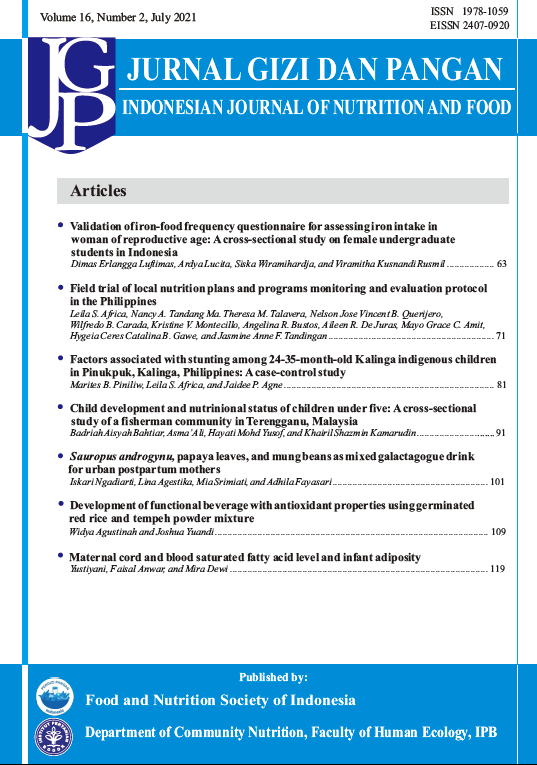Validation of Iron-Food Frequency Questionnaire for Assessing Iron Intake in Women of Reproductive Age: A Cross-Sectional Study on Female Undergraduate Students in Indonesia
Abstract
The aim of this study is to develop and assess the validity of the Iron-Food Frequency Questionnaire (Iron-FFQ) in assessing the iron intake of reproductive age women. This cross-sectional study involved randomly selected female undergraduate students at Jantinangor, Sumedang district, West Java (n=94) as respondents. The validity test compared the iron intake using Iron-FFQ with the 3-Days Food Diary (FD). The iron contents of each food from both methods were obtained from Indonesian Food Composition Table (2017). Iron contents were analyzed using the Wilcoxon signed rank test and Spearman’s rank correlation. The results showed significant correlation in iron content between Iron FFQ and the 3 Days FD with r=0.25 for the tubers, nuts, and vegetables group, and r=0.21 for milk and fish (p<0.05). While, statistically non-significant correlations were found for the rest of the food groups (cereal, meat, poultry, eggs, fruits, fats, sugar, syrup, confectionary, and spices) with r ranged from r=0.19 to r=0.01. The average assessment value using Iron-FFQ was lower than the 3-Days Food Diary, especially in the food and beverages group (-100%), sugar, syrup, and confectionary (-93.8%), and vegetables (-88.5%). In conclusion, Iron-FFQ can be declared valid for measuring iron intake from some food group such as starchy tubers, fish, shellfish and shrimp, nuts, vegetables, and milk as they have an acceptable correlation value.
References
Anugerah S. 2018. Frekuensi sarapan dan persentase lemak tubuh mahasiswi fakultas Rumpun ilmu kesehatan Universitas Padjadjaran [Thesis]. Bandung: Universitas Padjadjaran.
[BKKBN] Badan Kependudukan dan Keluarga Berencana Nasional. 2015. Batasan dan Pengertian MDK. Jakarta (ID): BKKBN.
[BPPK] Badan Penelitian dan Pengembangan Kesehatan. 2013. Riset kesehatan dasar (RISKESDAS) 2013. Laporan nasional 2013. https://pusdatin.kemkes.go.id/resources/download/general/Hasil%20Riskesdas%202013.pdf [Accessed 21th February 2018].
[BPS] Badan Pusat Statistik. 2020. Persentase tenaga kerja formal menurut jenis kelamin (persen) 2018‒2020. BPS. https://bps.go.id/indicator/6/1170/1/persentase-tenaga-kerja-formal-menurut-jenis-kelamin.html [Accessed 1st July 2021].
Buscemi S, Rosafio G, Vasto S, Massenti FM, Grosso G, Galvano F, Rini N, Barlie AM, Maniaci V, Cosentino L et al. 2015. Validation of a food frequency questionnaire for use in Italian adults living in Sicily. Int J Food Sci Nutr 66(4):426‒438. https://doi.org/10.3109/09637486.2015.1025718
Fahmida U, Dillon DHS. 2011. Nutritional Assessment: Handbook. Jakarta (ID): SEAMEO RECRON UI.
Fitriananto DS, Widajanti L, Aruben R, Rahfiluddin MZ. 2018. Gambaran status gizi pekerja bangunan wanita di Kecamatan Tembalang Kota Semarang Tahun 2016. J-Kesmas 6(1):419‒425.
Gibson RS. 2005. Principles of Nutritional Assessment. New York (USA): Oxford University Press.
Głąbska D, Guzek D, Ślązak J, Włodarek D. 2017. Assessing the validity and reproducibility of an iron dietary intake questionnaire conducted in a group of young Polish women. Nutrients 9(3):199. https://doi.org/10.3390/nu9030199
Hakiki G, Supriyanto S. 2018. Profil Perempuan Indonesia 2018. Kementrian Pemberdayaan Perempuan dan Perlindungan Anak. Jakarta (ID): KPP, PA dan BPS.
[MoH RI] Ministry of Health Republic of Indonesia. 2013. Riset Kesehatan Dasar (RISKESDAS) Tahun 2013. Jakarta (ID): MoH RI.
[MoH RI] Ministry of Health Republic of Indonesia. 2018a. Hasil Utama Riset Kesehatan Dasar (RISKESDAS) Tahun 2018. Jakarta (ID): MoH RI.
[MoH RI] Ministry of Health Republic of Indonesia. 2018b. Profil kesehatan Indonesia 2017. MoH RI. https://pusdatin.kemkes.go.id/resources/download/pusdatin/profil-kesehatan-indonesia/PROFIL_KESEHATAN_2018_1.pdf [Accessed 21th February 2018].
[MoH RI] Ministry of Health Republic of Indonesia. 2018c. Tabel komposisi pangan Indonesia. MoH RI. https://panganku.org/id-ID/semua_nutrisi [Accessed 14th April 2019].
[MoH RI] Ministry of Health Republic of Indonesia. 2019. Peraturan Menteri Kesehatan Republik Indonesia nomor 28 Tahun 2019 tentang Angka Kecukupan Gizi yang Dianjurkan untuk Masyarakat Indonesia. Jakarta (ID): MoH RI.
Lombard MJ, Steyn NP, Charlton KE, Senekal M. 2015. Application and interpretation of multiple statistical tests to evaluate validity of dietary intake assessment methods. Nutrition Journal 14(1):1‒11. https://doi.org/10.1186/s12937-015-0027-y
Lopez-Arana S, Burdorf A, Avendano M. 2013. Trends in overweight by educational level in 33 low- and middle-income countries: The role of parity , age at first birth and breastfeeding. Obesity Reviews 14(10):806‒817. https://doi.org/10.1111/obr.12051
Lopez KDS, Takemoto Y, Garcia-Casal M. , Ota E. 2018. Nutrition-specific interventions for preventing and controlling anaemia throughout the life cycle: An overview of systematic reviews. Cochrane Database Syst Rev 2018(8):1‒14. https://doi.org/10.1002/14651858.CD013092
Nechitilo M, Nguyen P, Webb-Girard A, Gonzalez-Casanova I, Martorell R, DiGirolamo, et al. 2016. A qualitative study of factors influencing initiation and adherence to micronutrient supplementation among women of reproductive age in Vietnam. Food Nutr Bull 37(4):461‒474. https://doi.org/10.1177/0379572116647830
Pasricha SR, Low M, Thompson J, Farrell A, De-Regil LM. 2014. Iron supplementation benefits physical performance in women of reproductive age: A systematic review and meta-analysis. J Nutr 144(6):906‒914. https://doi.org/10.3945/jn.113.189589
Perdana SM, Hardinsyah H, Damayanthi E. 2014. Alternatif indeks gizi seimbang untuk penilaian mutu gizi konsumsi pangan wanita dewasa Indonesia. J Gizi Pangan 9(1). https://doi.org/10.25182/jgp.2014.9.1.%25p
Sauvageot N, Guillaume M, Albert A. 2013. Validation of the food frequency questionnaire used to assess the association between dietary habits and cardiovascular risk factors in the NESCAV study. J Food Sci 3(3). https://doi.org/10.4172/2155-9600.1000208
Shim JS, Oh K, Kim HC. 2014. Dietary assessment methods in epidemiologic studies. Epidemiol Health 36:e2014009. https://doi.org/10.4178/epih/e2014009
Steinemann N, Grize L, Ziesemer K, Kauf P, Probst-Hensch N, Brombach C. 2017. Relative validation of a food frequency questionnaire to estimate food intake in an adult population. Food Nutr Res 61(1). https://doi.org/10.1080/16546628.2017.1305193
Streppel MT, de Vries JH, Meijboom S, Beekman M, de Craen AJ, Slagboom PE, Feskens EJ. 2013. Relative validity of the food frequency questionnaire used to assess dietary intake in the Leiden Longevity Study. Nutr J 12(1):1‒8. https://doi.org/10.1186/1475-2891-12-75
Thompson FE, Subar AF. 2008. Dietary Assessment Methodology. Nutrition in the Prevention and Treatment of Disease. Third Edition. New York (USA): Elsevier Inc.
[WHO] World Health Organization. 2000. The Asia-Pacific perspective: Redefining obesity and its treatment. WHO. https://iris.wpro.who.int/bitstream/handle/10665.1/5379/0957708211_eng.pdf [Accessed 24th May 2021]
[WHO] World Health Organization. 2021. Anaemia. https://www.who.int/health-topics/anaemia#tab=tab_1 [Accessed 24th May 2021].
Willett W. 1990. Nutritional Epidemiology. New York (USA): Oxford University Press.
Authors

This work is licensed under a Creative Commons Attribution-ShareAlike 4.0 International License.






